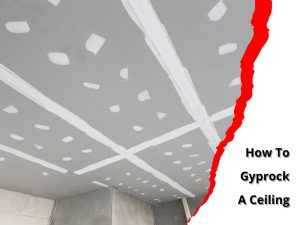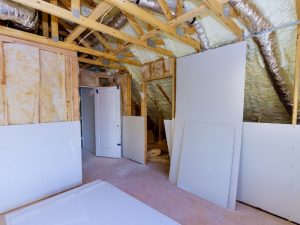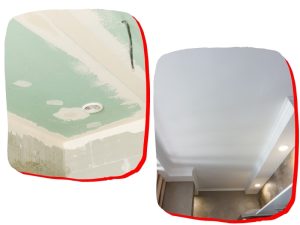How To Gyprock A Ceiling

Gyprocking a ceiling can give a room a fresh, clean look. It’s a rewarding DIY project that can be tackled with some preparation and the right tools. This article will walk you through everything you need to know to gyprock a ceiling, from the materials required to the final touches.
What tools and materials do you need for gyprocking a ceiling?
Gathering all the necessary tools and materials before you start is essential. Having everything on hand will make the process smoother and more efficient.
- Gyprock Sheets – Also known as plasterboard or drywall, these are the primary materials.
- Stud finder – To locate ceiling joists.
- Measuring tape – For accurate measurements.
- Utility knife – For cutting the gyprock.
- Drywall screws – To secure the gyprock to the ceiling.
- Drill or screwdriver – To drive in the screws.
- Joint tape – This is used to cover seams between sheets.
- Joint compound – For finishing the joints.
- Sandpaper or sanding sponge – To smooth out the joint compound.
- Primer and paint – For the final finish.
With these tools and materials ready, you can start your gyprocking journey!
How do you prepare the space for gyprocking?
Preparing the space is crucial for a successful gyprock installation. Here are the steps to ensure you’re ready:
- Clear the area: Remove any furniture and obstacles from the room. This makes it easier to move around and work safely.
- Inspect the ceiling: Check for structural issues like water damage, cracks, or inadequate ceiling insulation. Address these problems before proceeding.
- Measure the ceiling: Use measuring tape to measure the dimensions of your ceiling. This will help you determine how much gyprock you’ll need.
- Mark the studs: Use a stud finder to locate the ceiling joists. Mark their positions with a pencil for reference.
- Prepare for debris: Lay down drop sheets to protect the floor from dust and debris during the installation.
With a well-prepared space, you’ll find the gyprocking process much more manageable.
What are the steps to measure and cut gyprock sheets?
Measuring and cutting gyprock sheets accurately is vital to a successful installation. Here’s how to do it:
- Measure the sheets: Start by measuring the distance between the joists. Standard gyprock sheets are typically 1200mm x 2400mm, but you may need to cut them down to fit.
- Mark your cuts: Use a T-square and pencil to mark your cuts on the gyprock sheet. Ensure your lines are straight for a clean finish.
- Score the sheet: Using a utility knife, score along your marked line. Apply firm, even pressure.
- Snap the sheet: Once scored, bend the sheet along the line until it snaps. This creates a clean edge.
- Cut the paper backing: Use the utility knife to cut through the paper backing on the other side of the sheet.
With your gyprock sheets cut to size, you’re ready for installation.
How do you install the gyprock sheets on the ceiling?
Now comes the exciting part—installing the gyprock sheets! Follow these steps for a successful installation:
- Lift the first sheet: If you’re using a gyprock lifter, position it to hold the sheet against the ceiling. Otherwise, enlist a helper to lift the sheet into place.
- Align the sheet: Position the gyprock sheet so its edges are flush with the joists. Ensure the top is level.
- Secure the sheet: Using a drill or screwdriver, fasten gyprock screws into the joists, spacing them about 200mm apart. Be careful not to sink the screws too deep, as this can damage the sheet.
- Repeat for additional sheets: Continue installing sheets, ensuring they are tightly butted together.
- Check for level: As you go, check that your sheets are level and flush with each other. Adjust as necessary.
Once all sheets are installed, you’re well on your way to completing your gyprock ceiling.
How do you tape and finish the gyprock joints?
Taping and finishing the joints is essential for a polished look. Here’s how to do it properly:
- Apply joint compound: Use a plastering knife to spread a thin layer of joint compound over the seams where the sheets meet.
- Add joint tape: Place it over the compound while still wet. Press it down gently to ensure it adheres.
- Smooth the compound: Apply another layer of joint compound over the tape, feathering the edges to blend with the surrounding surface.
- Let it dry: Allow the compound to dry completely, following the manufacturer’s instructions.
- Sand the joints: Once dry, use a sanding block or electric sander to smooth the surface. Be careful not to over sand, as you want to avoid damaging the gyprock.
With the joints taped and finished, your ceiling will start looking fantastic!
What are the best practices for painting your gyprock ceiling?
Painting your gyprock ceiling can give it a fresh, new look. Here are some best practices to follow:
- Choose the right paint: Use ceiling paint designed explicitly for gyprock. This ensures proper adhesion and coverage.
- Prime the surface: If your gyprock is new, apply a primer before painting. This helps the paint adhere better and provides a more uniform finish.
- Use a roller: A paint roller is ideal for covering large areas quickly. Use a brush for corners and edges.
- Apply multiple coats: Depending on the colour and finish, you may need two or three coats for even coverage. Allow each coat to dry before applying the next.
- Maintain ventilation: Ensure the area is well-ventilated during painting to help the paint dry and reduce fumes.
How do you maintain your gyprock ceiling?
Once your gyprock ceiling is complete, maintaining it is crucial for longevity. Here’s how to keep it in top shape:
- Regular cleaning: Dust your ceiling regularly using a soft cloth or duster. This prevents dirt build-up and keeps it looking fresh.
- Check for moisture: Look for any signs of moisture or water damage. Address leaks or issues promptly to prevent further damage.
- Touch-up paint: If you notice any scuff marks or chips, touch up the paint as soon as possible. This helps maintain a polished appearance.
- Inspect for cracks: Periodically check for cracks or imperfections. If found, repair them with joint compound and repaint as necessary.
- Avoid heavy loads: Do not hang heavy objects from your gyprock ceiling, which can damage it.
With regular maintenance, your gyprock ceiling will look great for years.
Look no further if you’re considering a gyprock ceiling project and want professional assistance. Our expert team offers gyprocking services in Sydney, ensuring a flawless finish that will elevate your space. Talk to Mi Painting & Maintenance to discuss your project and experience a seamless gyprocking process!


